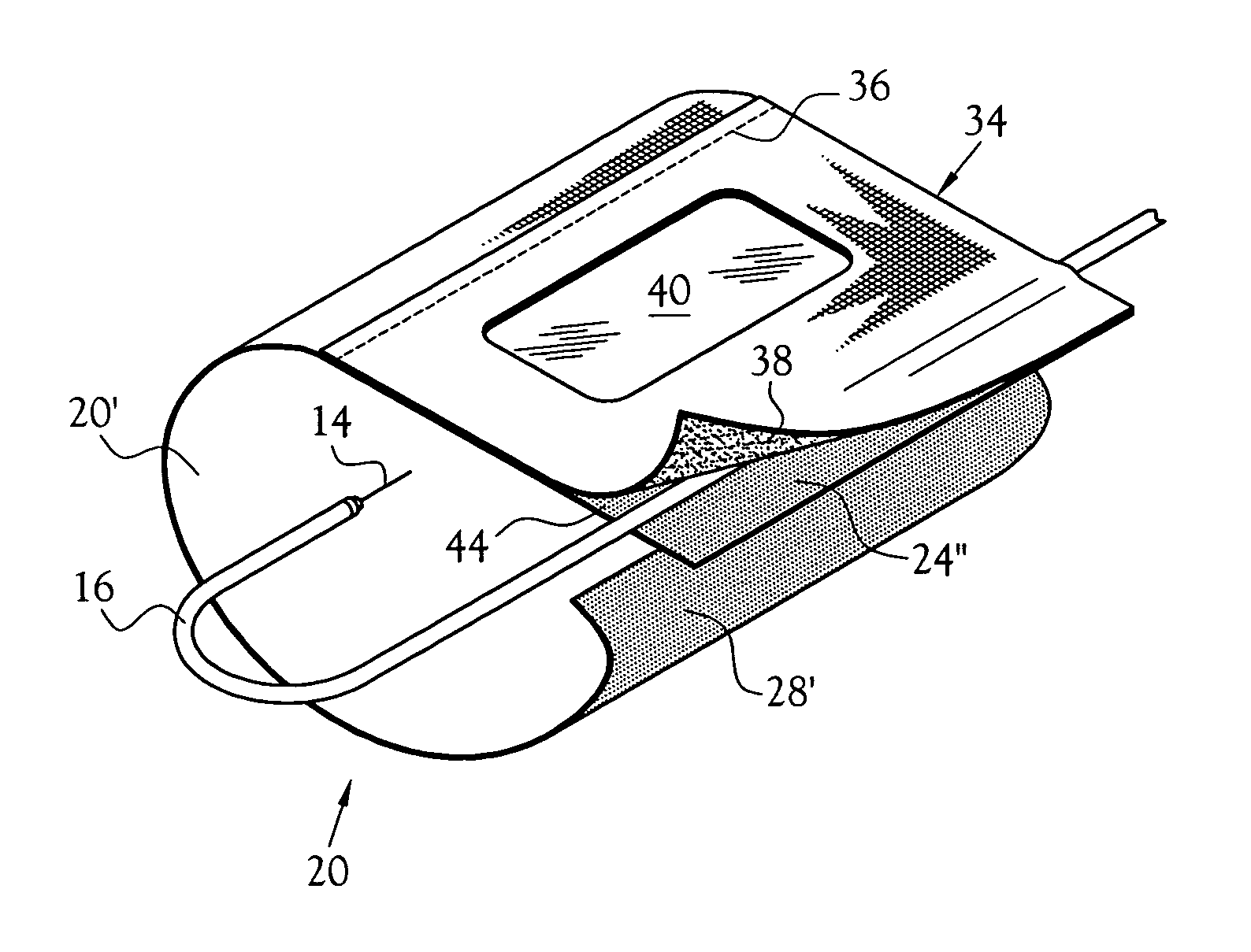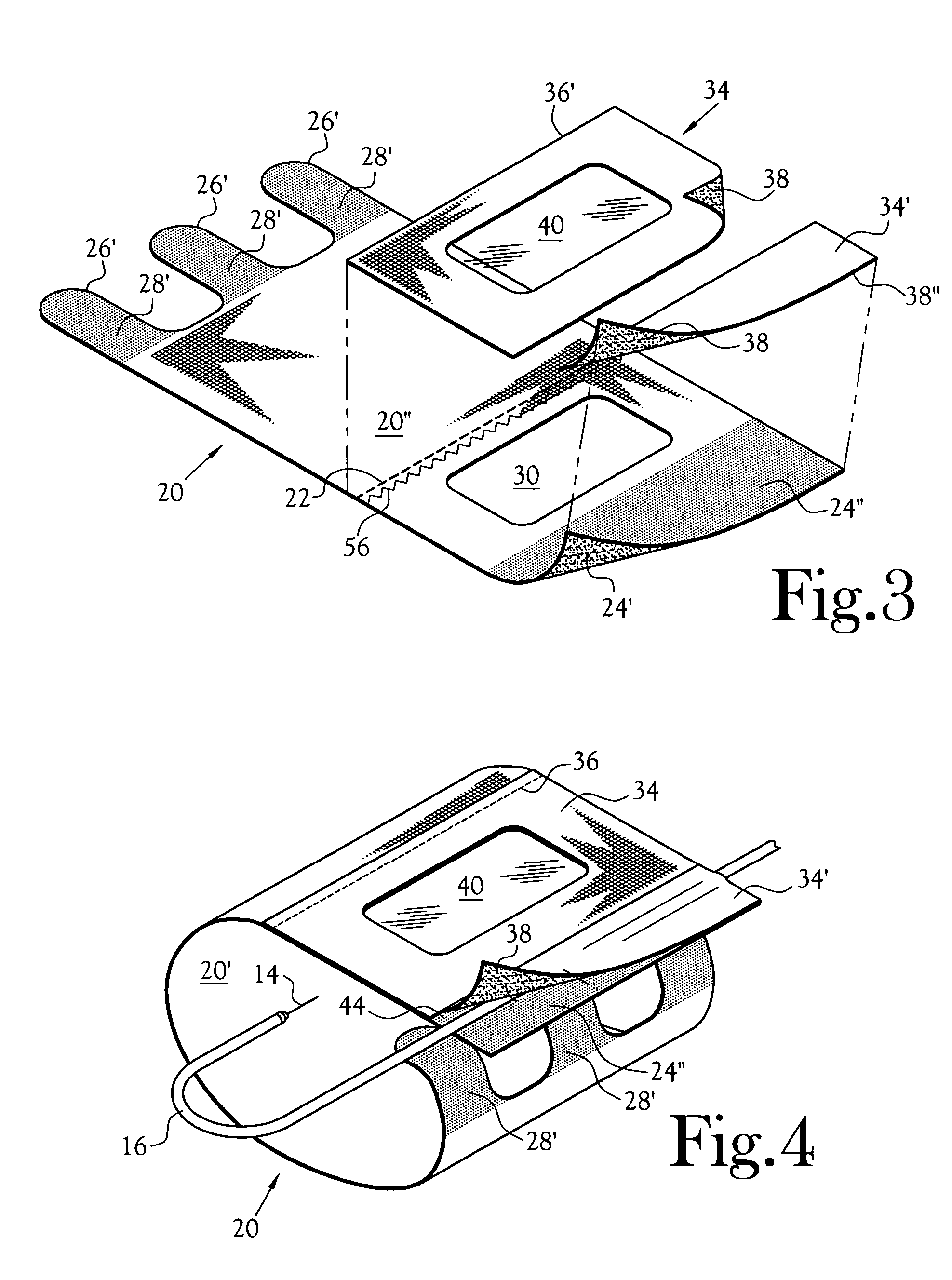Intravascular infusion site anti-tamper guard having means for site inspection
a technology for intravascular infusion sites and anti-tampering guards, which is applied in the direction of infusion needles, catheters, medical science, etc., can solve the problems of catheter displacement, catheter dislocation, frequent reuse of frequently used veins, etc., to minimize patient disruption of infusion site and associated tubing, and the effect of sufficient size and flexibility
- Summary
- Abstract
- Description
- Claims
- Application Information
AI Technical Summary
Benefits of technology
Problems solved by technology
Method used
Image
Examples
embodiment 150
[0058] A glove embodiment 150 is illustrated in FIGS. 17 and 18 and includes a glove shaped base panel 154 that is worn to cover a hand infusion site 152. In order to protectively cover the infusion site 152 on the dorsal side of the hand, a resilient flap 160 is utilized in a covering relationship to cover the infusion site 152. The flap 160 is extended from a base junction and seam 160′ that is hingedly attached by stitching proximal of a dorsal portion of the base panel 154. As illustrated in FIG. 17, the dorsal portion of the glove includes at least two finger holes 154′″, 154′″ serving as a binding for maintaining the glove shaped base panel 154 and panel open portion 154′ over the infusion site 152. The base panel 154 includes a first portion having a thumb opening therein, and includes a second portion identified as a base panel palmar portion 154″. Base panel 154 and palmar portion 154″ extend to encircle the patient's hand by releasably connecting proximal of the palm area....
embodiment 170
[0059] An alternative glove embodiment 170 is provided for covering a carpal and / or wrist vein or artery infusion site 172 is illustrated in FIGS. 19 and 20. A glove shaped base panel 174 includes a thumb opening and an elongated opening through which the patient's fingers extend. The base panel 174 includes an open portion 174′ within the portion of the panel covering the carpal area of the hand. The panel 174 further includes a first outer receiving surface 178 having first means for attaching 178′ thereon. A panel dermal receiving surface 176 includes a second means for attaching 176′ thereon, such as hook or loop fasteners, that are releasably engaged with an underside surface of the first means for attaching 176′ positioned along a palmar area of the patients hand.
[0060] A resilient flap 180 is extended in an overlapping relationship with the panel open portion 174′ in order to maintain a flap window 162 covering the carpal infusion site 172. The flap 180 includes an attaching ...
embodiment 200
[0061] A subclavian embodiment 200 includes positioning a guard device upon the dermal surface of a patient's upper right or upper left portion of his / her chest for covering a subclavian vein or artery infusion site 202 as illustrated in FIGS. 21 and 22. A subclavian base panel 204 is provided having a generally rectangular or pentagonal base of resilient material having an open portion 204′ therein. An upper side 206 of an outer faced panel surface includes means for attaching thereon, such as hook or loop fasteners, and a lower side 208 of the outer faced panel surface includes means for attaching disposed thereon. The base panel 204 includes means for retaining such as at least one torso strap 220 having at least one connecting end 222 with hook or loop fasteners thereon. The torso strap 220 is retained around the patient by extending the strap 220 between the panel lower means for attaching 208 and corner 208′.
[0062] As illustrated in FIG. 21, a resilient flap 210 is releasably ...
PUM
 Login to View More
Login to View More Abstract
Description
Claims
Application Information
 Login to View More
Login to View More - R&D
- Intellectual Property
- Life Sciences
- Materials
- Tech Scout
- Unparalleled Data Quality
- Higher Quality Content
- 60% Fewer Hallucinations
Browse by: Latest US Patents, China's latest patents, Technical Efficacy Thesaurus, Application Domain, Technology Topic, Popular Technical Reports.
© 2025 PatSnap. All rights reserved.Legal|Privacy policy|Modern Slavery Act Transparency Statement|Sitemap|About US| Contact US: help@patsnap.com



